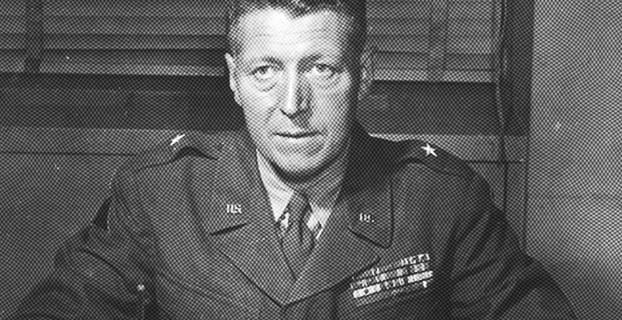General Bruce C. Clarke gave his now famous Leadership, Commandership, Generalship, and Followership speech to the 1962-63 graduating class of the Command and General Staff College. In it he discusses leadership, commandership, generalship, and followership. He uses examples of changing expectations that officers experience in a typical progression through their careers. This page contains a full text transcript of this speech as well as my favorite quotes, ideas, and frameworks from the speech.
General Bruce C. Clarke's Speech
I can assure you that it's a great privilege for me to return time Command and General Staff College even though this is the first time I have been permitted to be on this platform in civilian clothes. I’ve been here over a long period of time from time to time.
I entered here as a student 24 years ago. I've taken a great interest in the Command and General Staff College, because I was able to what in the field of Army Education on several occasions. I don't know that there is any institution in America that is so favorably known worldwide in military circles as your College.
And while I can't think of many things that I contributed to the College, I did contribute one thing that I think was important. I was responsible for changing the name of it from the Command and General Staff School to the Command and General Staff College. Now you may think that to be a play in semantics, but it isn't; it's important because, after all, you gentlemen here are getting the equivalent of your Master's degree in your profession.
I wanted to just talk with you this morning. I didn't come here to deliver a lecture. I came to talk to you about certain aspects of the job that you're learning to do. After all, this is the Command and General Staff College and that name was not arrived at without some thought, and of course it sets forth your mission for being here.
I was a troop commander for 13 straight years before I retired and that encompasses the career of a great many of you people, so that I didn't come here today to play over again the record that I think a lot of you have heard me play many times.
Leadership
You have a very good course at the College in leadership and l assure you that I'll not repeat that or go into the attributes that are required in the field of leadership. I think they are very well known.
They're not very complicated really. The art of leadership is only complicated to the theorists, it's not complicated to practical men.There are only a few, really a very few, simple rules and precepts that build makeup of character that are necessary to be better than a satisfactory leader and I'm sure that each one of you has passed that qualification or else you wouldn't be here.
I would like to go further into this particular field and point out to you that I believe we have become inexact in the use of terminology, because I was reading last night a memorandum which said that we teach leadership at the Command and General Staff College from the level of the division commander on up. I take issue with that statement for the reason that leadership is a peculiar art or a technique in itself and a division commander is not basically a leader.
He is a commander and I'm going to point out to you that you should adjust your thinking to a different point of view. I will talk to you briefly about what I call commandership and generalship which are quite different from being a leader.
Commandership and Generalship
If you will go to the title of the people who are in charge of military echelons, starting at the bottom, you'll first come to a squad leader, then a platoon leader, and every other title after that has the word commander after it. Why was that done? There are no company leaders; there are no battalion leaders; there are company, battalion, and brigade commanders and then you get to division commanding generals which is a further progression.
I'd like to point out to you that I hope that you will graduate with an appreciation of the transition that is necessary to go from leadership to commandership. I hope you don't think this old man now is involved in semantics because I hope I'm not. It's an important thing and a lot of people have never bridged it. They're still exercising leadership as company commanders or even when they get higher and by so doing they're bypassing or poorly using their subordinate commanders and staffs.
You came here to learn commandership or generalship and that involves the proper organization and utilization of subordinate commanders and staffs to accomplish what you want done with your command, and the technique is much different than the technique of getting in front of a platoon and saying, "Follow me," which is leadership.
But when you're in a different position with reference to your soldiers, then you become more or less a director and the technique of directorship is far different from the technique of saying, "Follow me."
I will give you a homely illustration. Suppose that you have a horse at A that you want to move to B. You take hold of the halter shank and he follows you on down the road; you're the leader. But if you get on and ride him you use different techniques; you use different aids; you use your legs and other things, that I learned in the ancient days when we had riding at West Point, to accomplish your purpose and I would say that that might be termed commandership. You're then the commander of the horse. You're not his leader but the purpose is the same, to move him from A to B. Now if you're affluent enough to own a sulky and drive him with reins and with a whip in your hand, then that's generalship. I bring that up because it isn't too far fetched in the problem that I would like to bring to you.
I will give you an historical example of a fellow who was a tremendous leader during the Civil War, probably one of the greatest leaders of the Civil War, and I use the term leader in the sense that I have used it up to now. A great leader in the Civil War was Hood who commanded the Texas Brigade. He was a most fantastic troop leader and sometime, if you'd like to look into it further, there's a very good book entitled, "The Gallant Hood," by John P. Dyer. Hood was a leader of the old school; in front of his men with his saber in his hand. That's how he handled his brigade, and it was an effective organization.
It was inevitable that a man with such capabilities would be promoted. He went up rapidly throughout the war. He ranked next to Lee at the end of the war, but when the war was over he had lost his command. It was a sorry ending to a man who had never mastered the transition from leadership to commandership to generalship.
When you move into the field of commandership, as against the field of leadership, you go to the techniques, or the art, of how you use your subordinate commanders to get the most out of them--the art and technique of how you organize and use your staff in order to enable you to carry out your job of directing, organizing and handling operations.
CHAIN OF RESPONSIBILITY. And also, you must realize, as you go up in the various echelons of organization of the Army, from the squad on up, you become increasingly removed from the individual soldier and your influence on the individual soldier no longer is carried on by an eyeball-to-eyeball approach. It's carried on through echelons of your command down to him, and you become increasingly just an image which you develop in several different ways; but you get into the a eld of proper staff organization and staff relationship because that is a very important part of commandership and generalship.
In your recent Military Review, there is an article on "Faulty Staff Relationships," I hope it will cause you to give a little thought to that problem because it is an important one.
You come to one of the most important parts of commandership and leadership, and that is establishing a chain of responsibility so that for ry man in your organization knows who he works for and who works for him.
That is basic. How many organizations have you been in where that wasn't known? I've been in several. I had no idea who I worked for or who made out my efficiency report. After all, there is one basic rule in the Army that you can't violate and I, over a period of 44 years, have tried to violate many of them. I have been successful in a few, but this one I have never been successful in, and that is you work and devote your loyalty to the man who makes out your efficiency report and the man who endorses it, If you don't do that, you're never going to be a general.
Establishing a chain of responsibility is just as important in your staff as it is in your command. If you don't have that, your headquarters mills around and creates what I call "command and staff inertia." That is a state of frustration and lack of purpose that exists in many military staffs.
Then of course it comes down to the art of commandership or generalship as to how you issue your directives or how you project your desires and will down through the command. It comes out in directives and so forth, which is an art within itself and which I am sorry to say we sometimes don't do very well. We could do a lot better than we're doing in that field. I've worked at times for a commander for whom I felt I wasn't doing a good job because the truth of the matter was I didn't know what he wanted me to accomplish.
IMPROVING YOUR UNIT. Now we get to the point of making progress as a commander. I can't conceive of anybody who takes over a company, a battalion, a brigade, or a division, or a corps, or a field army, who doesn't sit down and say to himself, how will I impress upon my superiors, the men who make out my efficiency report, that I am a good commander?
How do I do that? I've seen it done every way that you can think of in my career, but I would suggest to you that the best way to do that in a military organization is through the exercise of what I call "little pluses"--of making a little progress in every field, every day. Over a period of time, if you do that, your organization will tighten up, your organization will become good, and you'll gradually come up with the understanding and the reputation of really being a good commander. You will also not create turbulence which detracts from the effectiveness of your unit.
I've seen people walk into an organization and immediately start to make headlines. I would like to point out to you a great truth in the military that "He who lives by headlines is destroyed by headlines." Remember that if you start seeking headlines and creating images of yourself as a superman, pretty soon somebody will find a hole in your armor and when he does he will certainly give it to you. That follows from the rule about the monkey who climbs up a pole--the higher he gets, the more of his rear he shows to the people who are below him and that often goes for a person who goes up the chain of command in the echelons of the Army•
"CHANNELS OF SUGGESTION." I hope that I have impressed upon you that there is a technique in commandership and generalship--techniques that are different from leadership although the characteristics of the individual as to honesty and sincerity and all those other things are just as applicable. You have to master the transition as you go up.There's a little different technique being a company commander than from being a battalion commander. You have a bigger staff; you have more senior subordinate commanders and as you go up, that of course increases.
We talk about a chain of command--I have conscientiously tried throughout my career to live and conduct my job in such a way that I didn't exercise control of my organization through channels of command. I exercised it through channels of suggestion.
I think that is very important and I only used the channels of command when I wanted to discipline somebody, and I didn't have to do that very often. I figured that if I couldn't run an organization by getting things done by suggestion then I had failed as a commander. I commanded the troops of 12 nations as a corps commander in Korea. I didn't have any strong chain of command between me and the allied troops. If I put out something that I wanted done that violated their national ideas they didn't pay very much attention to it. In that case what are you going to do next?
I was down at the Infantry School and commented on this not long ago and one captain got up and he said, "General, I have listened very carefully to your channel of suggestion approach and I'm familiar with it.I served in your command in Europe and I think you have to be a very powerful suggester to make it work." Maybe that's true.
Followership
I want to get from there now to another subject and then I'll end up my presentation. That is the topic that fits right along with leadership, what I call followership. Everybody who is a leader or commander of any echelon is also a follower. You never get in the hierarchy of the Army to the point where you are not a follower.
The Chief of Staff of the Army is a follower; he follows the desires and directives of the President, Secretary of the Army, Secretary of Defense, the Joint Chiefs of Staff and so forth. Even the President of the United States is a follower in that he follows public opinion.
What you are today, each one of you, is the result of 35 to 40 years of following whereby you have taken into your makeup ideas, instruction, and concepts; and through a process of discernment, acceptance, and elimination you have stored away in your makeup certain characteristics, ideas, and procedures and you have discarded others.
In that process of sifting the good from the poor, or what you consider the good from the poor, you have created as of today your present makeup and character which is you as an individual. If you have attained good characteristics and a storeroom of good ideas, learning, and concepts that you can use effectively in the future, you have been a good follower. If you haven't you'll not be a good leader or a good commander.
It follows from that, that you must, through this process of discernment and storing away, create in yourself a balanced man--whereby you can handle concurrently all the different parts of the job. You don't concentrate on one and forget the other, such as maintenance; you don't concentrate on marksmanship and forget something else. The best organizations in the American Army are the organizations that are good or better in everything. They may not make many headlines, they may not be "superior" in any one thing, but they are our best organizations. These are the type of organizations that we want to develop in the Army.
I have tried to lead your thinking through the transition from leadership to commandership and generalship and to point out to you wherein followership is very important in this process of your development.
Progressing Up The Pyramid Of Life
It has been truthfully said that, at the end, when one looks back on his life, he should measure his success by the number of rungs up the ladder of life he has climbed since he started, and not by the particular rung on which he finished.
The basic concept of our Government under the Constitution is that all men are created equal. This means not that all men are equal, for they are far from it. It only means that all men should have equal opportunities and rights under our laws. This concept is a great step in the progress of man.
When any group of men such as Army officers, lawyers, doctors, engineers, scientists, clerks, or accountants start out in any corporation or in other organizations, they fit into a pyramid which is broad at the base, but becomes smaller and smaller as they approach the peak.
Assuming that those people in each category start with approximately equal backgrounds, there is a selection process which starts as soon as they tend to rise in the pyramid of life.
Also, assuming that the selection of those who rise in the pyramid of life is based upon ability, experience, need for special capabilities, and leadership, how does one prepare himself for being chosen to advance in competition with his associates and colleagues?
Everybody who is a leader, director, or commander at any echelon of an organization is also a follower. He never gets to the point where he is not.
The Chief of Staff of the Army is a follower--he follows the desires and directives of the President, the Secretary of the Army, the Secretary of Defense, and the Joint Chiefs of Staff. Even the President of the United States is a follower in that he follows public opinion.
What each one of us is today is the result of years of following whereby we have taken into our makeup knowledge, ideas, instruction, and concepts. Through a process of discernment, acceptance, and elimination, we have stored away in our personal ability banks certain characteristics, ideas, and procedures, and we have discarded others as not being worthy.
In the process of sifting the good from the poor, or what we considered the good from the poor, we have created, as of today, our present makeup and a character which is ours as individuals. If we have attained good characteristics and a storeroom of good ideas, learning, techniques, and concepts that we can use effectively in the future, we have been good followers. We have a good basis for being successful leaders and, in all probability, will advance. A good follower is able to react quickly and effectively to an emergency or a crisis. Hence, he has the potential to become a fine military commander.
This process must be continuous during our active careers if we are to continue to grow in judgment and balance. Some call this experience, but it is more than that. It is the constant and critical sound evaluation of experience that causes us to progress in stature and move up the pyramid of life.
Early in life, some members of society fall into limited categories due to handicaps of opportunities, health, and physical and mental ability. These people start life with ceilings over them that few are able to pierce.
But how about those whose opportunities, education, and apparent ability seem to start them off on common, equal footings as they begin to move up the pyramid of life? Each one eventually reaches his own peak and levels off at various distances from the top.
Very few have an apparent ceiling over them at the start, but they develop ceilings at various levels as they go along. What causes this leveling off process on the part of an individual? What factors tend to cause this ceiling to form over him?
Wrong decisions.
Wasted opportunities.
Deterioration of attitude and enthusiasm.
Excesses; lack of self-control.
Lack of honesty of purpose.
Tendency toward lowered standards.
Poor ethics.
Loss of self-respect.
Loss of motivation and ambition.
Lack of ability to express himself orally or in writing.
Poor associations.
Wrong scale of values.
Failure in carrying out responsibility.
Lack of loyalty, up or down.
Unfortunate family situations.
Deterioration of physical condition.
Bad habits.
Poor financial management.
Disregard of rules.
Procrastination.
Failure to keep up with progress in his field.
Poor fellowship is a great contributor to ceiling formation. Once a ceiling is formed, or starts to form, it is difficult to break through.
A few do break through despite handicaps, however. There are those who would try to dispel these ceilings by social laws and values. To be sure, they are partially successful on the lower reaches of the pyramid of life, but not as they reach the apex of the pyramid. They only warp the shape of the pyramid at certain levels. The Bible says that many are called but few are chosen. It is ever thus as we try to progress up the pyramid or ladder of life.
Who is General Bruce C. Clarke?
The late General Bruce C. Clarke, a graduate of West Point with an engineering degree from Cornell and a law degree from LaSalle, was a decorated combat commander under Patton at the Battle of the Bulge in World War II. He retired from the army in the 1960s, having held ranks from private to four-star general and earned the Distinguished Service Cross, three Distinguished Service Medals, three Silver Stars, and three Bronze Stars.
Bruce Cooper Clarke was a United States Army general. He was a career officer who served in World War I, World War II, and the Korean War. He was the commander of Continental Army Command from 1958 to 1960, Commander, United States Army Europe from 1960 to 1962, and commanded the United States Army, Pacific from December 1954 to April 1956.
Clarke's military decorations include the Distinguished Service Cross, three Army Distinguished Service Medals, three Silver Stars, the Legion of Merit, and three Bronze Star Medals. He also received decorations from foreign countries including France, Germany, Great Britain, Korea, and the Philippines.














